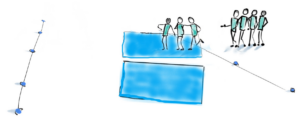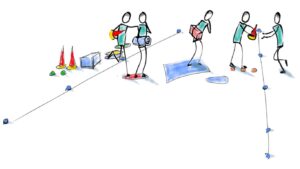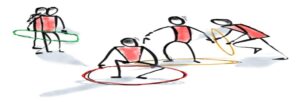Get lesson 1 of all sports: Sign up for a free pe planning membership
Orienteering
Learning Objectives
- Problem solve with other members of your team.
- Use communication skills to achieve success.
Curriculum information
Literacy Keywords
- Teamwork
- Communication
- Problem solving
- Cooperation
Citizenship
- Working as part of a team
Numeracy
- Time
Equipment
- Gymnastic mats
- Footballs
- Cones
- Hoops
- Marker spots
- Beanbags
Risk Assessment
- Suitable clothing and footwear worn by participants.
- Equipment suitable for participants, safe and checked.
- Area safe and checked - any hazards removed.
- Safety information highlighted to participants.
- Staff aware of all emergency procedures, including designated 1st aider.
Knowledge Checks
Throughout this plan you will see ‘Knowledge Checks’ to help you ensure the pupils are acquiring the intended knowledge as the lesson progresses. The two types of knowledge to focus on in PE are:
- Declarative Knowledge: Factual knowledge concerning movement, rules, tactics, strategies, health and participation (best practiced through spoken or written observations of a practical demonstration).
- Procedural Knowledge: Knowing how to apply declarative facts (best practiced through demonstration or participation).
Teacher Notes
- This is the first lesson in the orienteering unit of work.
- Orienteering is an exciting and inclusive sport that exercises the body and the mind. Children will develop communication and teamwork skills, as well as problem solving and map reading skills.
- The intention of the lesson is to give the children the opportunity to experience and explore problem solving activities for themselves in preparation for the Orienteering unit. There are two reasons for this:
- It is an introduction to OAA (outdoor adventurous activities) for the children. It gives them the opportunity to explore problem solving activities for themselves.
- It provides an opportunity for you to make an initial assessment of your class’s ability. By observing the children, you can make a judgement on their current level and the level at which you should set for teaching the rest of the unit.
Activities & Games
Chain Tag
3 - 5 mins- Set out an area for the children to play in.
- Select one child to be tagger.
- The taggers role is to try ‘tag’ the other children.
- When they ‘tag’ another child they form a chain with that child by holding hands.
- The pair of children are then ‘a chain of taggers’ – they then try ‘tag’ another child.
- Again, anyone caught by the chain, joins the chain to become a tagger.
- The chain keeps trying to catch other children.
SAFETY: Once the chain reaches 5 children, the next player tags starts a new chain.
- The game continues until all children in the class have been caught.

Teaching Points
- Communicate.
- Work together.
- Can only tag someone if the chain is linked together.
- Cooperate.
- Teamwork.
To make activity harder:
- Keep splitting the chains when they are 3 children long. Begin with more ‘taggers’.
To make activity easier:
- Play the game in a larger space.
Cross the River Introduction
5 - 10 mins- Split the children into 4 separate teams. Providing 2 gym mats for each team.
- Create a ‘river’ using a line of cones at one side of the hall, and a line of cones opposite.
- Children start at the same side of the hall / playing area.
- The task is to get their entire team to the opposite side of the hall / playing area without touching the floor.
- Only 3 people are allowed on each mat at any time.
- The first team to get all their team members to the other side wins.
- If a child touches the floor they must return to the starting point.

Teaching Points
- Communicate.
- Work as a team.
- Try out different ideas of moving on the bench – which proves to be more successful.
- Provide guidance if necessary.
To make activity harder:
- Reduce the number of children that are allowed on a mat at one time. Use hoops instead of mats.
To make activity easier:
- Use a point scoring system rather than starting again if a child touches the floor. Each time a child touches the floor they receive a point. The team with the least amount of points at the end, wins.
Cross the River
5 - 10 mins- Split the class into teams of 4/5.
- Use the same ‘river’ as above.
- Each group requires 3 ‘Stepping Stones’ (marker spots/hoops), and a variety of PE equipment.
- The challenge is for the group to transport themselves and their equipment across the river and back without ‘falling in’.
- If a team member or piece of equipment touches the ‘river’ the team must return to the ‘river bank’ they came from and start the travelling again.
- Children can decide how many travel across at a time, but everyone must take turns in travelling.
- There are some rules that must be followed:
– Stepping stones cannot be throw, or shuffled. They can only be placed down, and stood on.
– Stepping stones cannot move if a team member is standing on them.
– Only one piece of equipment can be carried at a time, per person.
– There is no limit to how many children stand on a stepping stone.
– Play for 5 minutes. After the time limit a point is scored for every team member and every piece of equipment, at the opposite side of the riverbank.

Teaching Points
- Explain the rules of the challenge and then let the children explore it and find a solution in their teams.
- Encourage the children to think of ways to complete the challenge as a team – create and develop a plan.
- The children must work as a team to complete the challenges.
- Work together, cooperate with each other.
- Try out ideas – do they work? If not how can the problems be fixed.
- Listen to everyone’s ideas.
- Observe children whilst playing the game – are they able to play it successfully?
- Is this the correct level at which to teach the rest of your unit?
- Provide advice and guidance if necessary.
- Allow the children to discuss their successes and challenges after the game. Play again, challenging them to score higher.
To make activity harder:
- Add ‘obstacles’ in the river that teams must avoid – in obstacles are touched, they receive a 10 second ‘freeze’ penalty. Use marker spots instead of hoops. Use more difficult equipment to carry. Blindfold a member of the team.
To make activity easier:
- Decrease the width of the river. Increase the size of the stepping stones. Increase the time limit.
Knowledge Check
- PROCEDURAL KNOWLEDGE: Ask some children to demonstrate the activity/skill.
- DECLARATIVE KNOWLEDGE: Ask other children to describe what is required to perform the task with success.
Hoop House
3 - 5 mins- Keep the children in their teams from above.
- Give each team 4 or 6 hoops each (depending on availability).
- Demonstrate the ‘hoop house’ (see teaching points).
- Ask children to create a hoop house, and allow 2 minutes.
- Once children have completed their sculpture they must try to crawl through it.
- Once everybody is through, they shake their bodies out for 10 seconds.

Teaching Points
- To build a hoop house…
– Place one hoop flat on the floor.
– Place 2 hoops at opposite inside edges, standing up and leaning into each other.
– If using 4 hoops, place the last hoop on top, to hold the 2 standing hoops in place.
– If using 6 hoops, before placing the hoop on top, place 2 standing hoops on adjacent inside edges to the already standing hoops, again leaning in.
- Children work together, calmly.
- Shake all their body out, including limbs and core.
Knowledge Check
How do you solve problems?
- Encourage the children to describe their experiences solving the problems in the lesson – talking to others, trying things, learning from things that don’t work, experimenting with what works, taking chances.
Why is working as part of a team important?
- Ask the children to explain how they worked as part of a team and why it helped them be successful.
- Working as a team gives you a better chance of being successful; teammates may have ideas and strengths that when combined with yours can make you a better team.
Get lesson 1 of all sports: Sign up for a free pe planning membership